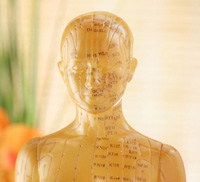Doctors from the University of Maryland School of Medicine, Baltimore and the University of Vermont College of Medicine, Burlington published a case vignette in the New England Journal of Medicine recommending acupuncture for the treatment of lower back pain. The article cites that patients with lower back pain account for over $90 billion in annual health care expenses in the US. The doctors conclude that acupuncture is an effective means for treating lower back pain based partly on a recent study of 6,359 patients published in Spine1. For the lower back pain patient in the case study presented, 10-12 acupuncture treatments over an 8 week period are recommended.
The doctors cite physiological phenomena that measure the effects of acupuncture. Local anesthesia at needle insertion sites block the the analgesic effects of acupuncture showing that acupuncture is dependent upon neural innervation2. Acupuncture has been proven to cause the release of endogenous opioids in brain-stem, subcortical, and limbic structures3,4. Acupuncture has also been proven to induce the secretion of adrenocorticotropic hormone and cortisol from the pituitary gland thereby creating a systemic anti-inflammatory response5. Functional MRI studies in humans reveal that acupuncture stimulates limbic and basal forebrain areas involved in pain processing6. PET scan MRIs (positron-emission tomography) show that acupuncture increases opioid binding potential in the brain for several days7. Acupuncture has also been proven to mechanically stimulate connective tissues8, release adenosine at the site of needle stimulation9, and increase local blood blow10. The doctors then cite clinical trials showing the efficaciousness of acupuncture in the treatment of thousands of patients10-15.
Despite this overwhelming evidence proving the mechanisms of action and efficaciousness of acupuncture, skeptics were outraged at the publication of an article supportive of acupuncture in the venerable New England Journal of Medicine. An article recently posted in the Forbes “science business” section stated that the article is “embarrassing” and that acupuncture “infiltrates” the University of Maryland Medical School. In the article, the author calls acupuncture “pseudoscience” and states that it is based on “magical thinking of non-existent life-force.” The skeptic author’s only proof of his theory is that one of the many studies cited in the article found that acupuncture was only 47.6% effective for the treatment of lower back pain and that sham acupuncture was 44.2% effective. Therefore, the author concludes that using “toothpicks” randomly on the human body will have the same pain relieving effects as acupuncture. What the author fails to mention in the Forbes attack article is that conventional western medicine therapy (a combination of drugs, physical therapy, and exercise) was only 27.4% effective in that very same study. Should we therefore abolish western medicine by MDs and call it pseudoscience? Acupuncturists have noted that the success of sham acupuncture noted in that particular study of 1,162 patients in Germany reveals that poorly placed acupuncture needles also derive benefit for the patient.
The author in the Forbes article does have an agenda, he calls for the elimination of the NCCAM (National Center for Complementary and Alternative Medicine), a division of the NIH (National Institutes of Health). He states that since acupuncture is poorly supported by research, the NCCAM should be abolished. The authors of the New England Journal of Medicine article contend that more research needs to be conducted on the efficacy of acupuncture based on existing and promising research. The authors suggest continuing acupuncture education and research as a means to better serve the public with quality medicine.
References
1. Yuan J, Purepong N, Kerr DP, Park J, Bradbury I, McDonough S. Effectiveness of acupuncture for low back pain: a systematic review. Spine 2008;33:E887-E900.
2. Wang SM, Kain ZN, White P. Acupuncture analgesia: I. The scientific ba- sis. Anesth Analg 2008;106:602-10.
3. Han JS. Acupuncture: neuropeptide release produced by electrical stimulation of different frequencies. Trends Neurosci 2003;26:17-22.
4. Pomeranz B. Scientific research into acupuncture for the relief of pain. J Altern Complement Med 1996;2:53-60.
5. Li A, Lao L, Wang Y, et al. Electroacupuncture activates corticotrophin-releasing hormone-containing neurons in the paraventricular nucleus of the hypothalamus to alleviate edema in a rat model of inflammation. BMC Complement Altern Med 2008;8:20.
6. Dhond RP, Kettner N, Napadow V. Neuroimaging acupuncture effects in the human brain. J Altern Complement Med 2007;13:603-16.
7. Harris RE, Zubieta JK, Scott DJ, Napa- dow V, Gracely RH, Clauw DJ. Traditional Chinese acupuncture and placebo (sham) acupuncture are differentiated by their effects on mu-opioid receptors (MORs). Neuroimage 2009;47:1077-85.
8. Langevin HM, Churchill DL, Wu J, et al. Evidence of connective tissue involvement in acupuncture. FASEB J 2002;16:872-4.
9. Goldman N, Chen M, Fujita T, et al. Adenosine A1 receptors mediate local anti-nociceptive effects of acupuncture. Nat Neurosci 2010 May 30 (Epub ahead of print).
10. Sandberg M, Lundeberg T, Lindberg LG, Gerdle B. Effects of acupuncture on skin and muscle blood flow in healthy subjects. Eur J Appl Physiol 2003;90:114-9.
11. Brinkhaus B, Witt CM, Jena S, et al. Acupuncture in patients with chronic low back pain: a randomized controlled trial. Arch Intern Med 2006;166:450-7.
12. Haake M, Muller HH, Schade-Brittinger C, et al. German Acupuncture Trials (GERAC) for chronic low back pain: randomized, multicenter, blinded, paralel-group trial with 3 groups. Arch Intern Med 2007;167:1892-8. [Erratum, Arch In- tern Med 2007;167:2072.]
13. Cherkin DC, Sherman KJ, Avins AL, et al. A randomized trial comparing acupuncture, simulated acupuncture, and usual care for chronic low back pain. Arch In- tern Med 2009;169:858-66.
14. Thomas KJ, MacPherson H, Thorpe L, et al. Randomised controlled trial of a short course of traditional acupuncture compared with usual care for persistent non-specific low back pain. BMJ 2006; 333:623.
15. Witt CM, Jena S, Selim D, et al. Prag- matic randomized trial evaluating the clinical and economic effectiveness of acupuncture for chronic low back pain. Am J Epidemiol 2006;164:487-96.


